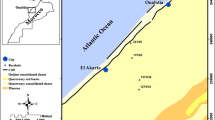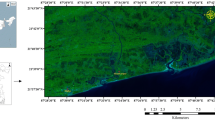Abstract
The Kovaya Limestone Mine is situated on the Saurashtra coast of India. Though the mine is dependent on the desalination plant installed in the plant for its domestic and industrial water requirements, there is significant withdrawal of groundwater by the large number of bore wells and open wells, which are present in the agricultural fields lying in and around the leased area of the mine. The heavy withdrawal of groundwater has led to intrusion of seawater. The present work entails study of possible seawater intrusion by chemical analysis of major cations and anions in selected groundwater samples. Very high total dissolved solids in the range of >1,000 mg/l and high chloride in the range of 103 mg/l to 3,899 mg/l have been measured in the groundwater samples. ‘Resistivity Imaging Survey’ has also been carried out on selected profiles in the study area. The Electrical Resistivity Tomography images indicate very low resistivity zones (~0–3 Ω m) in the bottom portion of the resistivity depth section. These low resistivity zones can be interpreted to be due to seawater intrusion. The resistivity sections on the excavated Pits, where mining is going on, indicate possibilities of seawater intrusion. Hence, protection from seawater intrusion is recommended through restriction of mining up to the safe level.
Similar content being viewed by others
References
Amer, A. M. (1995). Saltwater intrusion in coastal aquifers. Water Resources Management, 2, 521–529, 12–16 March 1995.
AGI. (2004). Earth Imager Software 2D version 1.7.9, 2004 edition.
APHA. (2005). Standard methods for the examination of water and wastewater (21st edn.). Washington DC: American Public Health Association.
Benson, A. K., Payne, K. L., & Stubben, M. A. (1997). Mapping groundwater contamination using DC resistivity and VLF geophysical methods—a case study. Geophysics, 62, 80–86. doi:10.1190/1.1444148.
Bernstone, C., & Dahlin, T. (1999). Assessment of two automated electrical resistivity data acquisition systems for landfill location surveys: Two case histories. Journal of Environmental and Engineering Geophysics, 4, 113–122.
Bugg, S. F., & Lloyd, J. W. (1976). A study of freshwater lense configuration in the Cayman Islands using resistivity methods. Quarterly Journal of Engineering Geology, 9, 291–302. doi:10.1144/GSL.QJEG.1976.009.04.02.
Choudhury, K., Saha, D. K., & Chakraborty, P. (2001). Geophysical study for saline water intrusion in a coastal alluvial terrain. Journal of Geophysics, 46, 189–200. doi:10.1016/S0926-9851(01)00038-6.
CMRI (2007). Geo-hydrological studies for Kovaya limestone mine of Ulltratech cement: A technical report of Central Mining Research Institute (CMRI);Ref No GC/MT/N/18/05–06, March, p.103.
Dahlin, T., Bernstone, C., & Loke, M. H. (2002). A 3-D resistivity investigation of a contaminated site at Lernacken, Sweden. Geophysics, 67, 1692–1700. doi:10.1190/1.1527070.
Ebraheem, A. A. M., Senosy, M. M., & Dajab, K. A. (1997). Geoelectrical and hydrogeochemical studies for delineating groundwater contamination due to salt-water intrusion in the northern part of the Nile Delta, Egypt. Groundwater, 35, 216–222. doi:10.1111/j.1745-6584.1997.tb00077.x.
Frohlich, R. K., Urish, D. W., Fuller, J., & Reilley, M. O. (1994). Use of geoelectrical method in groundwater pollution surveys in a coastal environment. Journal of Applied Geophysics, 32, 139–154. doi:10.1016/0926-9851(94)90016-7.
Ginsberg, A., & Levanton, A. (1976). Determination of salt water interface by electrical resistivity sounding. Hydrological science bulletin, 21, 561–568.
Griffth, D. H., & Turnbull, J. (1985). A multi-electrode array for resistivity surveying. First Break, 3, 16–20.
Griffth, D. H., Turnbull, J., & Olayinka, A. I. (1990). Two-dimensional resistivity mapping with a computer controlled array. First Break, 8, 121–29.
GWRDCL (2006). A technical report on groundwater investigation and groundwater potential details around Narmada cement factory. Jafarabad, Dist, Amreli, Gujarat: Gujarat Water Resources Development Corporation Ltd (GWRDCL).
GCW (2006). Personal communication on Gujarat cement works (GCW). Gujarat.
Howard, K. W. F., & Mullings, E. (1996). Study of groundwater flow and saline water in the Clarendou basin, Jamaica. Groundwater, 34, 801–810. doi:10.1111/j.1745-6584.1996.tb02074.x.
Koefoed, O. (1979). Geosounding principles 1, resistivity sounding measurements. Amsterdam: Elsevier.
Loke, M. H., & Barker, R. D. (1996). Rapid least squares inversion of apparent resistivity pseudosection using quasi-newton method. Geophysical Prospecting, 44, 131–152. doi:10.1111/j.1365-2478.1996.tb00142.x.
Loke, M. H., Acworth, I., & Dahlin, T. (2003). A comparison of smooth and blocky inversion methods in 2D electrical imaging surveys. Exploration Geophysics, 34, 182–187. doi:10.1071/EG03182.
Mercado, A. (1985). Use of hydro-chemical pattern in carbonate, sand and sandstone aquifers to identify intrusion and flushing saline water. Groundwater, 23, 635–645. doi:10.1111/j.1745-6584.1985.tb01512.x.
Meju, M. A. (2000). Geo-electrical investigation of old/ abandoned, covered landfill sites in urban areas: Model development with a genetic diagnosis approach. Journal of Applied Geophysics, 44, 115–150. doi:10.1016/S0926-9851(00)00011-2.
Naik, P. K., Dehury, B. N., & Tiwary, A. N. (2007). Groundwater pollution around an industrial area in the coastal stretch of Maharastra state, India. Environmental Monitoring and Assessment, 132, 207–233, Medline. doi:10.1007/s10661-006-9529-6.
Nowroozi, A. A., Stephen, B. H., & Henderson, P. (1999). Saltwater intrusion into the freshwater aquifer in the eastern shore of Virginia: A reconnaissance electrical resistivity survey. Journal of Applied Geophysics, 42, 1–22. doi:10.1016/S0926-9851(99)00004-X.
Parker, R. L. (1977). Understanding inverse theory. Annual Reviews in Earth and Planetary Sciences, 5, 35–64. doi:10.1146/annurev.ea.05.050177.000343.
Pujari, P. R., Pardhi, P., Muduli, P., Harkare, P., & Nanoti, M. V. (2007). Assessment of pollution near landfill site in Nagpur, India by resistivity imaging and GPR. Environmental Monitoring and Assessment, 13, 489–500. doi:10.1007/s10661-006-9494-0.
Rai, S. N. (2004). Role of mathematical modeling in groundwater resources management, Sri Vinayaka Enterprises. Hyderabad, 434–445.
Revelle, R. (1941). Criteria for recognizing sea water in groundwater. American Geophysical Union Transactions, 22, 593-597.
Shammas, M. I., & Jacks, G. (2007). Sea water intrusion in the Salalah plain aquifer, Oman. Environmental Geology, 53, 575–587. doi:10.1007/s00254-007-0673-2.
Saxena, V. K., Krishna, K. V. S. S., Singh,V. S., & Jain, S. C. (2002). Hydro-chemical study for delineation of fresh groundwater region in the Potharlanka, Krishna Delta, India. In B. V. Rao, K. R. Reddy, C. Sarala, K. Raju (Eds.), Hydrology and watershed Management, International Conference, J.N.T.U. Hyderabad, (vol. 1, pp. 200–211). Hyderabad: B.S. Publisher.
Saxena, V. K., Mondal, N. C., & Singh, V. S. (2004). Evaluation of hydrogeochemical parameters to delineate fresh groundwater zones in coastal aquifers. Journal of Applied Geochemistry, 6, 245–254.
Saxena, V. K., Singh, V. S., Mondal, N. C., & Maurya, A. K. (2005). Quality of groundwater from Neil island, Andaman & Nicobar, India. Journal of Applied Geochemistry, 7, 201–206.
Subba Rao, N. (2002). Geochemistry of groundwater in parts of Guntur district, A.P. India. Environmental Geology, 41, 552-562.
Urish, D. W., & Frohlich, R. K. (1990). Surface electrical resistivity in coastal groundwater exploration. Geo- exploration, 26, 267–289. doi:10.1016/0016-7142(90)90008-G.
Vandam, J. C., & Meulankamp, J. J. (1967). Some results of the geo-electrical resistivity method in groundwater investigations in the Netherlands. Geophysical Prospecting, 15, 92–115.
Wilson, S. R., Ingham, M., & McConchie, J. A. (2006). The applicability of earth resistivity methods for saline interface definition. Journal of Hydrology, 316, 301–312. doi:10.1016/j.jhydrol.2005.05.004.
Zohdy, A. A. R. (1969). The use of Schlumberger and equatorial soundings on groundwater investigations near El Psso Tx. Geophysics, 34, 713–728. doi:10.1190/1.1440042.
Author information
Authors and Affiliations
Corresponding author
Rights and permissions
About this article
Cite this article
Pujari, P.R., Soni, A.K. Sea water intrusion studies near Kovaya limestone mine, Saurashtra coast, India. Environ Monit Assess 154, 93–109 (2009). https://doi.org/10.1007/s10661-008-0380-9
Received:
Accepted:
Published:
Issue Date:
DOI: https://doi.org/10.1007/s10661-008-0380-9




